Drip irrigation
![drop drop]()
How does drip irrigation?
What are its advantages and what kinds of technologies exist?
In this series of articles we will try counseling to answer these and other questions.
Drip irrigation was established as the most appropriate and effective way of watering the plants in regions with severe and harsh climatic conditions and limited water resources. This method of irrigation was the only variantom.resheniya problems when limited water resources could be applied for a maximum area of irrigation and reduce useless water wastage to a minimum.
Israel is faced with this problem in the middle of the last century. The country is located in the desert of natural-climatic zone with very scarce water resources. In Israel, a serious approach to solving this problem, because the survival of the country depended on the ability to provide the population with food at the expense of their own agriculture. To solve this problem began large-scale scientific research, technological development and technical equipment for the production of this type of irrigation. Our country is the first in the world to use drip irrigation on an industrial scale. In many ways, precisely because of drip irrigation, managed from a half-starved country with a rapidly growing population and the card system of food distribution, to become a country that has become a few years a major exporter of agricultural products.
 Starting from the 1960s, the beginning of drip irrigation is widely spread throughout the world. Farmers realized that using drip irrigation, they can increase yield, reduce costs and significantly reduce water consumption. In the 80-ies of the last century, drip irrigation has become the most popular form of irrigation of crops in all countries, regardless of climatic conditions. In today's market of irrigation equipment, drip irrigation is widely used in agriculture, gardening and improvement of human settlements, in landscaping and in small private plots. Drip irrigation is the way to a slow, gradual supply of water directly into the zone of roots of the plant. By maintaining an optimal level of humidity in the soil, it has a low loss by evaporation and drainage. Water is not wasted on soil moisture where it is not needed, that is, between the rows, and free areas of the plant. The root zone is maintained in an ideal moisture level. The soil not covered by a crust that creates the optimal balance of water and aeration of the soil in the root zone.
Starting from the 1960s, the beginning of drip irrigation is widely spread throughout the world. Farmers realized that using drip irrigation, they can increase yield, reduce costs and significantly reduce water consumption. In the 80-ies of the last century, drip irrigation has become the most popular form of irrigation of crops in all countries, regardless of climatic conditions. In today's market of irrigation equipment, drip irrigation is widely used in agriculture, gardening and improvement of human settlements, in landscaping and in small private plots. Drip irrigation is the way to a slow, gradual supply of water directly into the zone of roots of the plant. By maintaining an optimal level of humidity in the soil, it has a low loss by evaporation and drainage. Water is not wasted on soil moisture where it is not needed, that is, between the rows, and free areas of the plant. The root zone is maintained in an ideal moisture level. The soil not covered by a crust that creates the optimal balance of water and aeration of the soil in the root zone.
Using this method of irrigation, we create optimal conditions for plants for their growth, development and fruiting.
Low cost of equipment and the possibility of complete automation of irrigation, as well as the supply of nutrients (fertilizers), irrigation water, allow at minimum cost, to get the maximum effect, to save water and fertilizer.
Sometimes people think that everything is very simple: take a nail and do in ordinary plastic pipe openings through which water will drip ...
However, it is not. Conduct an experiment, and you will see that out of the holes will hit the water jet. The more holes are from the beginning of the pipe, the amount of water will decrease. It turns out that somewhere "thick", but somewhere - "empty". The problem of uniform water supply over the entire length of the pipeline, and in a strictly predetermined amounts has been solved when the invented dropper. Dripper is a device which meters the amount of water at its outlet. The basic design of the dispenser - it is thin and long maze. Currently, a large number of different designs droppers, which are becoming a perfect and efficient to use. For example, only in Israel, which is deservedly considered the world leader in drip irrigation systems, has 4 large, well-known worldwide by the manufacturer of drip irrigation and these companies for many decades lead the market and constantly develop new design and improve their products. Innovative solutions have enabled a new generation of drippers, which work very stable, have a low water consumption per unit of time, have the ability to self-cleaning and allows to save materials in their production.
Droppers are produced in two types: simple labyrinth and compensated. Simple droppers have one drawback: the water flow, ie the outflow of water from a drip depends in a pipe that does not allow to use long lines of water pressure. The second type drippers - compensated, can work in a wide range of pressures and ensure uniform outflow of water from each emitter.
Droppers are built into dropping the phone and there are external, which are mounted on the outside, an ordinary plastic pipe.
You've probably heard the term: drip tape. This kind of a dropping tube, which has a low price, uncompensated dropper and a thin shell thickness of 150 - 250 microns. Such tapes are made of cheap simplify the technology and have a short lifespan - Season 1, ie it is a disposable product. Qualitative drip tubes with compensated drippers, designed for continuous operation in harsh field conditions for several years. Resource of drip tubes up to 7 years or more.
The main technical parameter drip tube - this performance. Performance droppers defined in liters per hour, i.e. how many liters of water coming out of one drip per hour. Performance droppers ranges from 0.8 to four liters per hour. Droppers is a high technology manufacturing a precision technology, so the spread flow from separate dropping pipe droppers for example dlinnoy100 meter does not exceed 5-10% of the 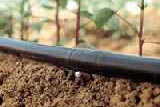
main applications of drip irrigation based on current compensated droppers: greenhouses, outdoor series with long and complex topography (elevation change). Drip irrigation is used in the open field for the cultivation of legumes, corn, sunflower, cotton, melons, salads, vegetables, beets and other field crops.
Drip irrigation is very effective in horticulture, viticulture and berry fields.
Increasingly, drip irrigation is used for gardening of settlements and landscape design.
An additional advantage of drip irrigation systems should include the possibility of irrigating a large area than in conventional irrigation. Saving and efficient use of water is very important if your water source has a limited flow rate, and your farm can be successful and profitable only for high and stable yields of crops that you grow.
Drip irrigation may also be operated at a low water pressure. For instance, sprinklers and irrigation powerful system effectively uses water under pressure in the system at least several atmospheres and the drip irrigation works perfectly even with a fairly low water pressure in the irrigation sitemy ranging from 0.6-1.5 bar, which saves energy and a more simple and inexpensive pumps.
All that has been said about the benefits of drip irrigation systems, allows you to use this method of irrigation for efficient and economical irrigation of most plant species.
Design droppers.
Each of the manufacturers producing hundreds of varieties of drip tubes and external droppers. The question arises: why are so many varieties and designs?
If the farmer uses drip irrigation, then that person has set itself the specific task - to ensure the plants with water optimally.
As selected the desired type and design of intravenous drip irrigation or hose, we will look at later, but for now examine the structure built dropper.
Design droppers. Built-dropper.
Current technologies allow producing pipes in special lines where the plastic hose extrusion process combined with inside tube assembly droppers. Such technology has enabled low cost manufacture hoses with different hose wall thickness and different design droppers for different operating conditions.
These types of irrigation systems have a long service life, adapted to the most complex and unusual climatic conditions, topography, etc.
Cylindrical labyrinth dropper:

Standard cylindrical labyrinth dripper

Standard cylindrical labyrinth dripper

Compensated cylindrical dripper

Compensated cylindrical dripper 2
Cylindrical labyrinth emitter were the first developments in this industry.
Flat labyrinth dropper:
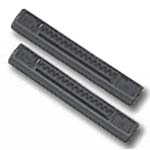
Uncompensated flat dripper
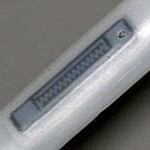
Simple uncompensated flat dripper

Compensated flat vortex dropper
Compensated flat vortex dropper
Compensated dropper includes a built-in filter, a valve and a labyrinth through which the water passes. This precision of components and accuracy of their performance depends dropper performance, measured in liters per hour and the accuracy of the entire system and stability over a wide temperature range, elevation, and other external factors.
According to standards, the water flow variation of drippers along the entire length of the tube must not exceed 10%, in practice, this figure does not exceed 3-4%.
The flat design uncompensated drippers allows their use in thin-walled tubes with a wall thickness of 0.15 to 0.85 millimeters. These tubes and lungs, when wound into a bobbin, become flat. But for those in the thin tubes winded form and rise to the term "tape".
Each tube type drippers can be fitted with different performance.
- Performance droppers is from 0.8 to 8.0 liters per hour.
- The distance between droppers: 10-150 cm.
- Hose length, at which the performance is guaranteed with a spread of droppers 10%.
- water pressure. Usually from 0.3 to 4.5 bar.
These parameters are very important, as they allow to pick up the phone, it is suitable for your particular irrigation conditions.
Exterior droppers.
This was one of the first development droppers, which were mounted on the tube by hand. These types of droppers are still used successfully, particularly in small-scale irrigation areas and in cases where the distance between the drippers may be different, and so they are successfully used in greenhouses, landscape design, in hydroponics systems and in landscaping.
There are several varieties of droppers different in design.
Drippers Types:


"Katif"
Miniature dropper-type "Katif" , the simplest and most inexpensive of all manufacturing industry.
It can be mounted in plastic tubes of almost any size and wall thickness to 2.0 mm.
The only requirement - the pipe should be slightly elastic.
On the left - itself a dropper, and the photo on the right - this is the dropper. It can be clearly seen on the hose next to a bush cucumber.
Supertif
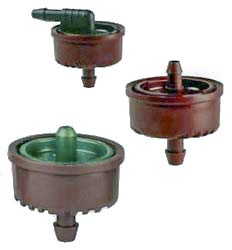
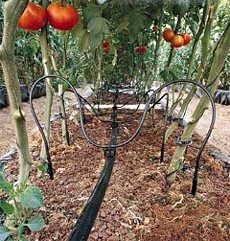
The next generation of external droppers - a "Supertif".
They have a higher accuracy, it is possible to use a greater number of intravenous lines on one line, and they have an additional advantage - the upper part (tube) can be put on a special fitting - a splitter, and water can be supplied to several plants, e.g., 2 meters, 3 meters or four of additional weir tubes.
Installation of external droppers:
To fix a drip on the tube, it is necessary to make a hole a special tool. He pierces a hole of the desired diameter with smooth edges.
Attention! Once you have made the hole for droppers, it should immediately insert the drip! This ensures a tight fit it into place.
Once the hole is prepared, you need to insert the drip. This will require some effort, since a dropper very close fit in the hole in the pipe. Pressing do at temperature not less than 20 degrees Celsius. At lower temperatures, the elastic tube is insufficient. For large projects, it is advisable to use a special tool for pressing droppers. Using the tool accelerates and improves the quality.
Place the required number of intravenous lines in the right places along the length of the tube, and your drip irrigation system is ready for operation.

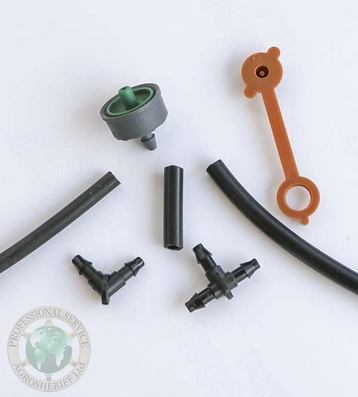
Droppers "Supertif" and similar dropper, mounted in the same manner as the other outer dropper. The plastic pipe is necessary to make a hole for fitting, in which is then pressed into a dropper, and the output connector you need to put a tube through which water will be supplied to the plants. At the end of the tube it is necessary to wear a special tip, which is stuck into the ground next to the plant and fixes the water outlet in exactly predetermined point.
If the additional length of the tube to support it is necessary to use special additional holder.
On the left you see a drip assembled.
You just have to stick it in the hole made in a plastic tube.
Installation droppers type "Supertif".
The opening in the tube is done the same instrument and the same as for droppers "Katif", but Punch diameter is needed for these drippers 3.0 millimeters, while for droppers "Katif" 4.0 millimeter. Further operations on the installation, you can look at in the photo.
Mounted on a drip can be put on a connector for output 1, for 2 and 4 outputs. In the splitter, by means of special tubes with an internal diameter of 3 mm and an outer diameter of 5 millimeters, connecting lugs, which are inserted in the ground or in the substrate near the plants to be watered.
Splitter mount to drip for 1, 2 or 4 directions. Attach the tube and the second end of the tube, put on a special tip.
This option is also very useful for irrigation of potted plants. Tips are inserted next to the stem, and your plants will always feel comfortable.
The figure below schematically shows how a drip irrigation for the four plants can be used.
On the outlet pipe dropper worn splitter having four output nozzle, which is put on the hose 4 with the lugs. Tips are stuck into the soil next to the plants that need to be watered.
There are different designs with the number of output taps fittings from one to four.
4-Way - open field and 2-Way potting:
Using external droppers with couplers is very useful for irrigation of plants grown in pots or containers.
For this purpose, the dropper capacity of 4 liters per hour, with the splitters 4 lines 1 and 2 liters per hour and at 1 or 2 outputs.
Drip irrigation is the most advanced and cost-effective way of watering the plants. Do not forget that the irrigation system should contain not only the drip tube and dropper.
The following items should be classified as mandatory components of the irrigation system:
- Transmission and distribution pipelines.
- Connecting fittings.
- Guaranteed source of water.
- Pumps for supplying water to the system (pump station).
- An apparatus for filtering water (water filters).
- fertigation apparatus (Equipment for the metered addition of fertilizers in irrigation water).